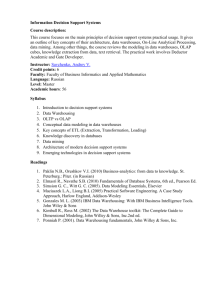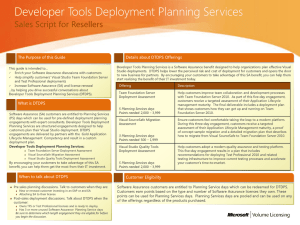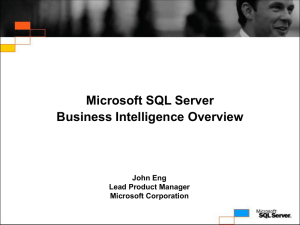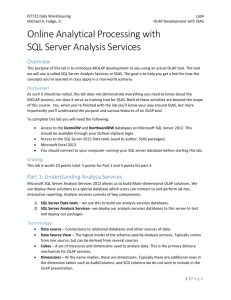Case PowerPoint slides
advertisement
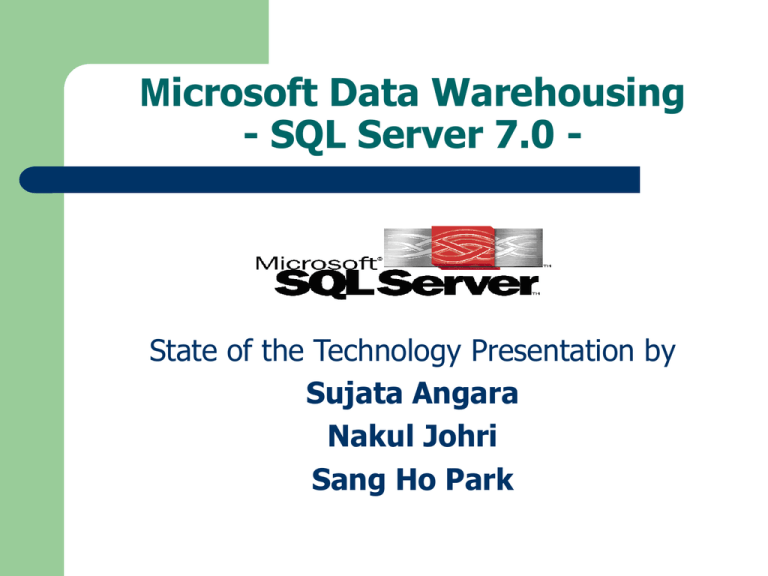
Microsoft Data Warehousing - SQL Server 7.0 - State of the Technology Presentation by Sujata Angara Nakul Johri Sang Ho Park Microsoft’s Data Warehousing Strategies Reducing complexity Reducing costs Increasing scalability Reducing Complexity Released Two Technical Specifications OLE DB for OLAP provides a common interface for front-end analysis tools to access OLAP engines Open Information Model (OIM) - a metadata classification and organization standard Reducing Costs Bundled OLAP Services and supporting technologies (DTS and an English Query frontend interface) free with SQL Server 7.0. Cheaper than most standalone OLAP servers Addressing Scalability Database that can scale upwards to up to 3TB Scale downwards into the small and midsize business (SMB) market Microsoft Data Warehousing Products Two products that address the server and client SQL Server 7.0 and Office 2000 (Excel 2000 in particular) Data Warehousing Requirements Access to diverse information sources Integrating and consolidating information from heterogeneous data sources Data warehouses SQL Server 7.0 Features Scalable Business Solutions Powerful Data Warehousing Integration with Microsoft Office 2000 Scalable Business Solutions Terabyte-sized database support Scalability Easy to Build, Manage, and Deploy Designed for Mobile Computing An Ideal Platform for Commerce Powerful Data Warehousing Database with Integrated OLAP and Data Transformation Services (DTS) Integration with the Microsoft Repository Advanced query processor Visual Data Tools Integration with Microsoft Office 2000 New Microsoft Data Engine (MSDE) New PivotTable® Service SQL Server 7.0 OLAP Services Overview: Very low data retrieval performance Data sources can include any OLE DB Client-slide cache Calculation engine- PivotTable® Service SQL Server 7.0 OLAP Services Salient features: Ease of Use Flexible data model Elimination of the Data Explosion Syndrome Intelligent client/server data management SQL Server 7.0 OLAP Services Salient features: Highly scalable architecture Extensibility Wide availability of desktop application clients Low cost of ownership Microsoft Data Warehousing Framework Easily integrated with and extended by third-party vendors Import, export, validation, and cleansing services Integrated metadata for data warehouse design Core management services Microsoft Data Warehousing Framework Data Warehousing Framework Components Two enabling technologies The integrated metadata repository The data transport layer (OLE DB) Industry Standards and Other Vendors: SAS Systems Inc ERP Solutions Enterprise Miner S/W SAP AG’s R/3 HR Vision Native compatibility is not a ready feature Rapid Warehousing Methodology Measurable business benefits within a 90day project cycle Industry Standards and Other Vendors: Sybase Adaptive Server IQ Column based indexing Performance optimized algorithms Case Study: Shoney’s Restaurants Background Platforms Issue Description Product Functionality Strengths Weaknesses Technical Support Case Study: Shoney’s Restaurants Performance Evaluation – – – – Initial load of two to three years of historical data Nightly incremental updates that exceeded 120,000 rows per day Modified several Microsoft Access-based sales analysis applications Analyze and report a variety of sales result Microsoft Limitations A complete range of knowledgemanagement systems requires other tools, notably ETT tools Even the enhanced spreadsheet applications with Excel 2000 will still provide only rudimentary analysis Microsoft Limitations Scalability of SQL Server 7.0 not yet proven These competitive claims were crystallized in "Oracle Million Dollar Challenge" Microsoft does not have a satisfactory answer to this Microsoft’s Answer Partnered with NCR to integrate its high-end Teradata server with SQL Server 7.0 Questions? THANK YOU

